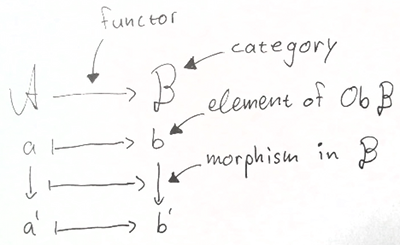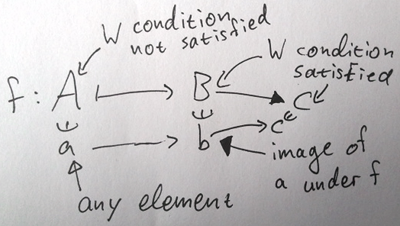An arrow notation for annotations
Saturday, October 27th, 2012 | Author: Konrad Voelkel
Nowadays it is common to use  to denote that an element
to denote that an element  is mapped to an element
is mapped to an element  by the map(ping)
by the map(ping)  . In particular, the arrow
. In particular, the arrow  (in LaTeX: \rightarrow) denotes a map, or more generally a morphism, while
(in LaTeX: \rightarrow) denotes a map, or more generally a morphism, while  (in LaTeX: \mapsto) denotes how particular elements or objects are mapped to other elements or objects.
(in LaTeX: \mapsto) denotes how particular elements or objects are mapped to other elements or objects.
Have you ever seen an arrow which has a triangle as head? Like those:


it doesn't happen very often, and the reason is that it's not part of the standard LaTeX language, you need to include extra packages.
This seems unfortunate, but it can be a useful fact. Since this kind of arrow doesn't appear often in mathematical articles when printed out, it has most likely no mathematical meaning assigned to it. This means you can use this arrow for annotation on the blackboard!

It happens from time to time that I get annoyed by someone drawing minus signs instead of bullet points to enumerate equations, which contain signs themselves. Equally annoying is a blackboard full of commutative diagrams, where some of the arrows are not arrows in some category but just annotations, like here:

Non-filled triangle heads are slightly too similar to standard arrows. I want you to use only arrows with filled triangles at the head for annotation. Thank you so much!
Technical hints:
- \rightarrowtriangle from \usepackage{stmaryrd} produces an arrow with non-filled triangle.
- In Zapf Dingbats there is an arrow with filled triangle head, you can get it via \ding{221} from pifonts.
- \usepackage{amsmath} provides \blacktriangle and its friends \blacktriangleup, \blacktriangleleft, \blacktriangleright which could be used to define an annotation-arrow.
- In xypic, it seems to be difficult to get an annotation-arrow.
- In Unicode you can get "⇾" by code 021FE, as I learned from this Unicode-LaTeX table.
- In TikZ it is easy (as everything in TikZ) to get any kind of arrow you can not even imagine. See TeXample.
